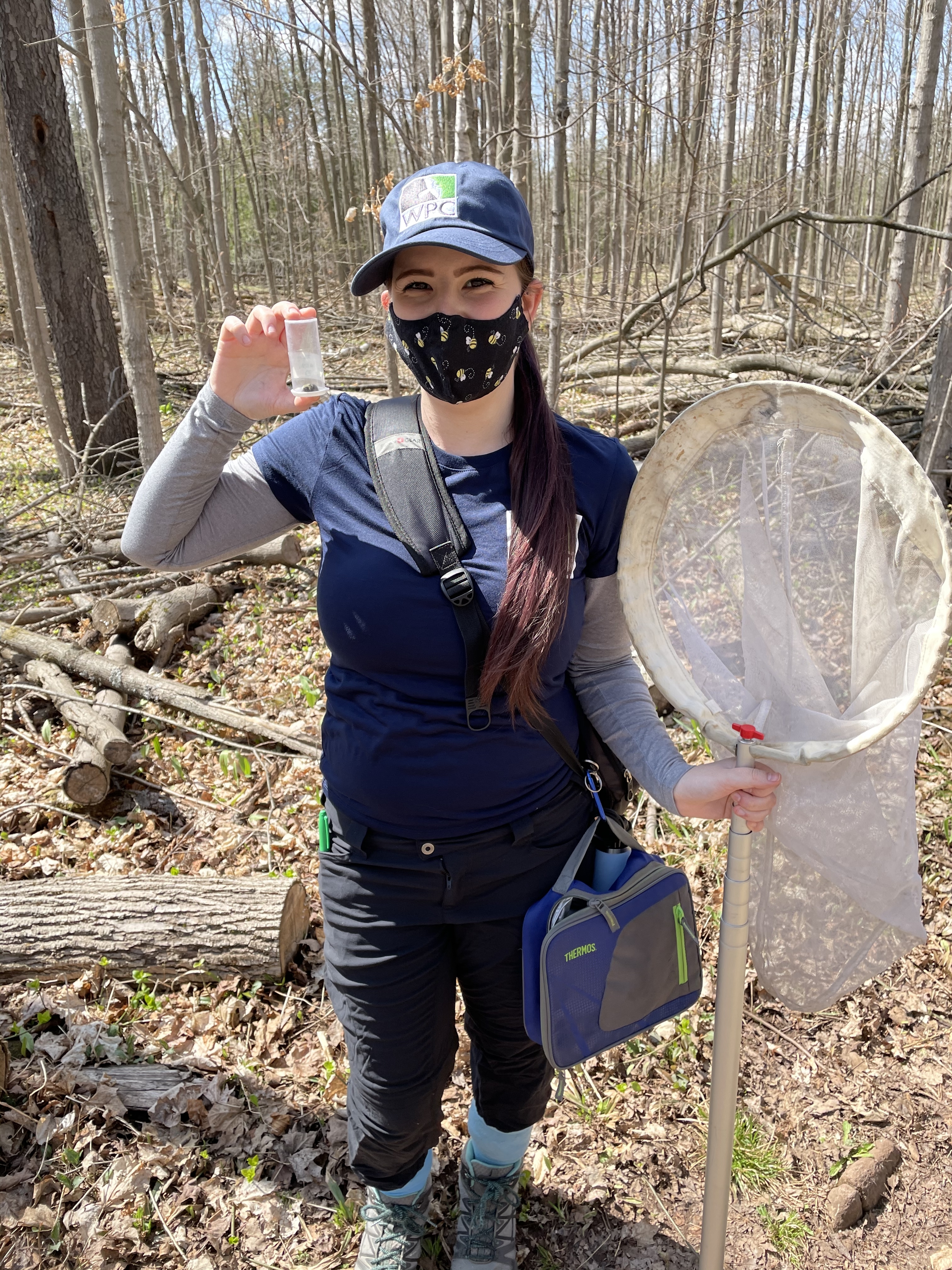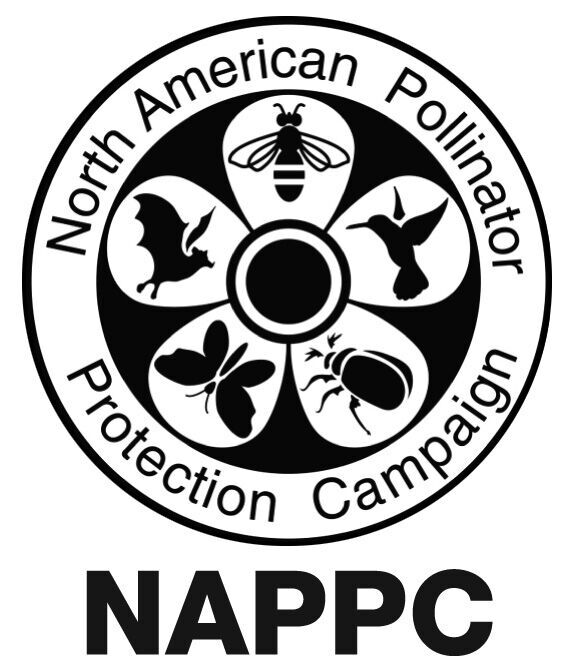Tiffani Harrison, Ontario Program Coordinator at Wildlife Preservation Canada
Tiffani Harrison with the first bumble bee queen caught last year, a two-spotted bumble bee. Photo courtesy of Sarah Mackell.

Food, spices, oils and fibers – pollinators excel at making these items possible. The complexity of the pollinator world is astounding because of the roles they play and their vitality to healthy ecosystems. We celebrate these achievements through the incredible people and projects that are working to conserve pollinators. We hope these stories encourage and empower you to better understand who our pollinators are and what actions you can take to help them.
Bumble bees are an important group of native pollinators. There are almost 50 species of native bumble bees in North America. It is estimated that roughly 25 percent of North American bumble bees are in decline. We interviewed Tiffani Harrison Ontario program coordinator for Wildlife Preservation Canada on her work with their Bumble Bee Recovery Program.
Q: How would you describe this effort?
A: Wildlife Preservation Canada’s Native Pollinators Initiative launched the Bumble Bee Recovery Program in 2013 to develop and maintain a variety of bumble bee conservation projects. Our current projects include establishing breeding colonies for the yellow-banded bumble bee, conducting annual population surveys, hosting educational workshops and collaborating scientific research. Though our bumble bee recovery program is based in Ontario, we have been building relationships to extend this community science initiative to Alberta. Expanding to Alberta has the goal of working with the western bumble bee once reliable conservation intervention techniques are developed for this bee. We also have interest in expanding the program to additional bumble bees in other areas in Canada.
Q: What got you interested in or inspires you about pollinators?
A: It started in high school while learning how to shoot macrophotography with my camera. Getting up close images of plants had me chasing insects too, many of them pollinators. Upon graduation, Wildlife Preservation Canada hired me as a bumble bee technician and I fell in love with the job of catching bees to study them for conservation action.
Yellow banded bumble bee worker on daisy. Photo courtesy of Tiffani Harrison.
Q: Which pollinators does your project/organization seek to help and what makes your efforts unique?
A: The bumble bee breeding program is our highest priority. We are currently developing techniques to establish conservation breeding colonies of at-risk native bumble bee species. Observing all aspects of the bumble bee lifecycle will help us increase understanding and the possibility to safely reintroduce them into their historic habitat range. Originally, rusty patched bumble bee was our primary species. However, after intensive annual searches throughout Ontario, our team was unable to locate a single bee in this area of historical range. The last sighting occurred in 2009 at Pinery Provincial Park in southwestern Ontario. So, we turned our attention to the closely related yellow-banded bumble bee. Using this bumble bee as a surrogate, we are developing conservation breeding techniques for the rusty-patched bumble bee to be used if and when populations of this imperiled bee are found.
Another aspect to improve our understanding of bumble bee populations is having three field crews conduct surveys throughout Ontario. We target historic and current locations, with the goal of expanding the survey area every year. This data allows us to track the diversity and ranges of at-risk bumble bees over time. This includes monitoring rusty-patched bumble bee, gypsy cuckoo bumble bee, American bumble bee and yellow bumble bee.
Q: What successes have you achieved?
A: Our provincial-wide survey is the longest running data set for Ontario on bumble bee populations. The annual spring survey has recorded more than 20,000 bumble bees. Bumble Bee Watch at Pinery Provincial Park, which started in 2016, observed the rare lemon cuckoo bumble bee every year except in 2020, and the American bumble bee for several years mostly at the same site. Nearly 2,700 records submitted from the park identified 10 species. These observations make up nearly 18 percent of all submitted observations for Ontario, and six percent of all submitted observations in Canada. Also, the conservation breeding program has colonies successfully producing workers, males and new queens across multiple bumble bee species.
Q: What is your biggest challenge?
A: There are knowledge gaps of bumble bee ecology, like their overwintering process. Trying to simulate this part of their life cycle in the lab is really hard when we don’t know how it is done in the wild. That is why it is really important to partner with researchers that are investigating these knowledge gaps. It is useful for the community and for us to perfect our protocols in our conservation breeding lab. We also only collect bees where populations are stable, and these locations are moving further away from our lab. To help solve these issues, we recently completed a long-term strategic plan identifying priority actions with a designated timeline.
A community science training program at Glenbow Ranch Provincial Park in Alberta. Photo courtesy of Julia Millen.
Q: How do you engage with your community in regard to this work?
A: We welcome the community to be collaborative with us and our partners through Bumble Bee Watch to track and conserve North America’s bumble bees. This volunteer community science program contributes significant data about our native bumble bees. To help learn the survey techniques that professional researchers use, we developed a training program. That became so popular, we expanded our volunteer opportunities by offering train-the-trainer program. This is for organizations and landowners interested in running their own volunteer-based survey program using Bumble Bee Watch. Through this multi-leveled instruction program, we hope to expand search efforts across the country, growing our organizational capacity for training community citizen scientists to locate and identify native bumble bees. We also attend conferences and deliver educational content online to maintain an active position in the pollinator conservation community in Canada and abroad.
Q: What is something about pollinator conservation or your project/organization you wish more people knew?
A: We offer specialized training for bumble bee identification and survey protocol. We create materials and resources to inform more people about these opportunities. We are always happy to get more people involved in bumble bee conservation!
Q: What is the best way to get involved in your conservation work?
A: People can join us through participating in Bumble Bee Watch in their area. We also accept donations for those looking to make a financial contribution to Wildlife Preservation Canada’s Bumble Bee Recovery Program.

Alone no individual or entity can address all pollinator conservation needs, but through collaborative conservation we can and will make a difference for pollinators and the ecosystems they help support. Keep following our Pollinator Conservation Spotlight series to hear more inspiring pollinator conservation stories. Do you know a great project or organization that is addressing critical pollinator conservation topics and deserve their moment under the spotlight? Let us know!
Article contributed by Mara Koenig, U.S. Fish and Wildlife Service for the NAPPC Pollinator Communications Taskforce.
